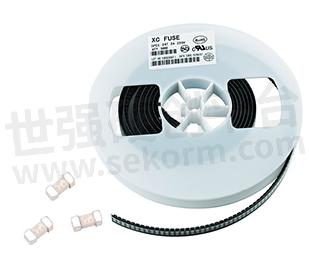Discussion on the Testing Method of Chip Fuses




We know that there are many series of fuses in the electronic component market, including patch fuses. This series of fuses is commonly used in factories, with few being used by individual users. But what should we pay attention to when testing patch fuses? Today, editor Dai Liang, let's take a look together. Firstly, The detection method for patch fuses is recommended to be based on the following aspects: normal current, fusing current, open circuit voltage, short circuit current, impulse current, and ambient temperature.
1. Normal current: Firstly, we must know the normal current flowing through the fuse in the circuit used. Usually, we need to pre-set a derating amount and choose according to the following principle: the normal current must be less than the product of the rated current and the derating coefficient.
2. Fusing current: According to UL specifications, the fuse should quickly fuse at twice the rated current. But in most cases, to ensure reliable fusing, we recommend that the fusing current should be greater than 2.5 times the rated current. In addition, if the fuse time is important, it must also refer to the fuse characteristic diagram provided by the manufacturer to make a judgment.
3. Open circuit voltage: The open circuit voltage should generally be selected to be less than the rated voltage. For example, when using a fuse with a rated voltage of DC24V in an AC100V circuit, it may ignite the fuse or cause it to rupture.
4. Short circuit current: We refer to the maximum current that flows when a circuit is short-circuited as the short circuit current. For various fuses, the rated breaking capacity is specified, and we must be careful not to eXCeed the rated breaking capacity when testing Chip Fuses. If a fuse with a small breaking capacity is selected, it may cause the fuse to rupture or cause a fire.
5. Impulse current: Observe the waveform of the impulse current and calculate its energy using the I²t value. The impact on the fuse varies depending on the size and frequency of the impulse current. The ratio of the I²t value of impulse current to the I²t value of single pulse fusing determines the number of times a fuse can withstand impulse current. (Recommended reading: Can a self-restoring fuse replace a disposable fuse tube?

Fig.1
- +1 Like
- Add to Favorites
This document is provided by Sekorm Platform for VIP exclusive service. The copyright is owned by Sekorm. Without authorization, any medias, websites or individual are not allowed to reprint. When authorizing the reprint, the link of www.sekorm.com must be indicated.
Recommend
Selection Techniques and Installation Process of Chip Fuses
2023-11-25 - Design Article The fusing current of patch fuses is 1.5 to 2.0 times the rated current. When electrical equipment is in normal use, its fuse will not blow. When the current in the circuit exceeds 5 times its rated current, it will automatically fuse to provide protection. If the fuse of the electrical equipment blows during normal use, it indicates that the current in the circuit exceeds the rated value. Therefore, the cause should be promptly investigated.
How to Design Chip Fuses
2023-11-27 - Design Article In electronic products, chip fuses have two functions: protecting end users from harm and protecting circuits from damage. These functions benefit both device users and manufacturers. Over the past decade, the demand for electronic devices serving information technology, mobile, and consumer applications has sharply increased in the market. With this rapidly growing demand, the risk of unexpected situations in electronic devices has also increased, requiring the use of overcurrent protection devices such as chip fuses to avoid risks such as electrical overload.
Selection Techniques for Chip Fuses
2023-12-25 - Design Article Firstly, normal current: Firstly, we must know the fuse that flows through the circuit chip used in normal current. Usually, we need to reduce the difference between the predetermined amount and then follow the selection principle: the normal current must be less than the rated current and the product‘s derating factor.
Basic Knowledge of Chip Fuses
2023-12-13 - Technical Discussion Firstly, understand the function of fuses: Place the circuit fuse correctly. Then, the fuse will rise to a certain height and after a certain period of time, the fuse will cut off the current, thus protecting the operation of the circuit. The principle of patch fuses is the same, but the style is different. Below, we will have a detailed understanding.
Temperature Characteristics of Current Fuses
2024-11-16 - Technical Discussion Current fuses exhibit specific temperature characteristics that play a crucial role in their performance and reliability. The behavior of a current fuse in response to temperature changes is determined by several factors.
Selection of Current Fuses in Automotive Circuits
2024-11-16 - Technical Discussion In automotive circuits, the selection of current fuses is of great significance for ensuring the safe operation of the vehicle. There are several key factors to consider when choosing a current fuse for an automotive circuit.
Precautions for Selecting Chip Fuses
2023-11-26 - Design Article With the development of highly integrated electronic products such as digital cameras, laptops, and smartphones, and urgent need for factories to adopt full automation to reduce high labor costs in the market environment. Chip fuses are widely used in overcurrent protection applications, but due to differences in technology, they have different advantages compared to plug-in self-recovery fuses. At the same time, chip fuses also have some of their own weaknesses.
How to Choose the Rated Voltage and Current of Chip Fuses
2024-01-18 - Design Article How to choose the rated voltage and current of a patch fuse: The rated voltage of a patch fuse depends on the current flowing through it, and is not related to the working voltage of the circuit. From the perspective of safe use, the rated voltage of SMD fuse is proposed, which is the highest working voltage of the circuit when the SMD fuse is in a safe working state. This means that fuses can only be placed in circuits with a working voltage less than or equal to the rated voltage of the fuse. Only in this way can the fuse operate safely and effectively.
Encapsulation Forms of Current Fuses
2024-11-13 - Technical Discussion The encapsulation of current fuses is an important aspect that affects their performance, durability, and safety.
What Parameters Should be Noted for Patch Fuses
2023-12-18 - Design Article A circuit is composed of wires and electronic components, and the parameters of SMD fuses required by different circuits vary. The main parameters of SMD inductors include inductance, allowable deviation, distributed capacitance, rated current, and quality factor.
Some Knowledge about Patch Fuses
2024-01-08 - Design Article The fuse breaking current of the patch fuse is 1.5 to 2.0 times the rated current. When electrical equipment is in normal use, its fuse will not break. When the current in the circuit exceeds 5 times its rated current, it will automatically break to provide protection. If the fuse melts during normal use of electrical equipment, it indicates that the current in the circuit exceeds the rated current. Therefore, the cause should be immediately investigated.
The Role of Current Fuses in Smart Meters
2024-11-08 - Technical Discussion Current fuses play a vital role in smart meters. Firstly, they provide protection against overcurrent events. Smart meters are used to measure and manage electricity consumption accurately. However, electrical circuits can sometimes experience sudden surges in current due to various reasons such as power outages and subsequent restoration, short circuits in the electrical grid, or the malfunction of connected electrical appliances.
Main Parameters for Selecting Patch Fuses
2023-12-03 - Design Article The voltage rating of the fuse must be greater than or equal to the high voltage of the disconnected circuit. Due to the very low resistance of the fuse, the voltage rating of the fuse becomes important only when the fuse attempts to blow. After the fuse element melts, the fuse must be able to quickly disconnect, extinguish the arc, and prevent the open circuit voltage from triggering the arc again through the disconnected fuse element.
Supplementary knowledge on purchasing chip type fuses
2023-12-31 - Design Article Fuses (patch type fuses), also known as fuses, as the name suggests, are used to protect circuit components. When the current exceeds the specified range of the electrical appliance, the fuse will heat up and blow, thereby achieving the purpose of cutting off the current and protecting the electrical appliance. Supplementary knowledge on purchasing chip type fuses.
Several Factors Influence the Lifetime of Current Fuses
2024-11-06 - Technical Discussion The lifetime of a current fuse is influenced by several factors. Firstly, the current rating of the fuse plays a crucial role. If a fuse is constantly operating near or at its rated current, it will experience more heat buildup and stress over time, which can shorten its lifetime.
Electronic Mall
Integrated Circuits
Discrete Components
Connectors & Structural Components
Assembly UnitModules & Accessories
Power Supplies & Power Modules
Electronic Materials
Instrumentation & Test Kit
Electrical Tools & Materials
Mechatronics
Processing & Customization
























































































































































































































































































































































































































































































































































































































































































































































































































































































































































































